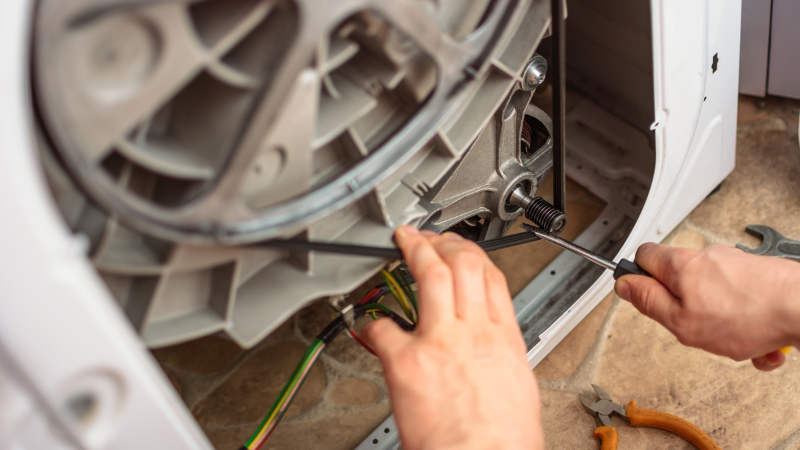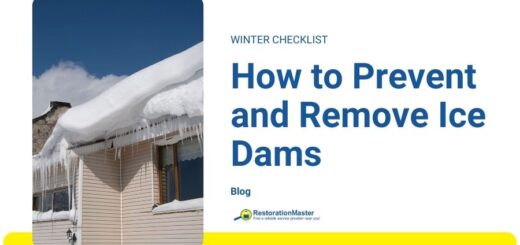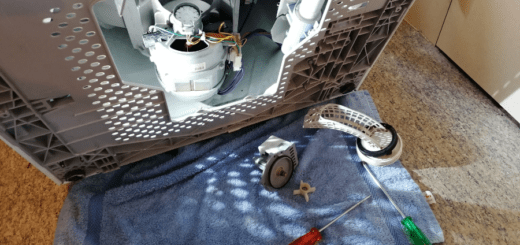What to Do When the Water Leaks Behind the Washing Machine?

Washing machines utilize lots of water. In fact, the standard washing machine, one that is not high-efficiency, pushes 19 gallons of water per load. It’s inevitable that the appliance may start to leak at some point. Here’s what to do when water leaks from behind the washing machine.
A puddle of water on the floor can startle a homeowner who’s just run the washing machine. Identifying where the pool of water originated can help the homeowner identify the cause and the solutionA solution is a homogeneous mixture of two or more substance... More. Most commonly, leaks from the washing machines come from the backside or underside.
1. Use high-efficiency detergent
The choice of detergent can cause leaks from behind the washing machine. Some laundry detergents produce a large amount of suds, some of which can leak out from the back of a front-load washer. The water may be soft, or the detergent too strong, overly concentrated, or excessive.
A homeowner can check the puddle of water to determine if it is sudsy, slippery to the touch, or contains soap. Any of these cues indicate that the leak in the washing machine is caused by the detergent. Prevent future leaks by using HE, or high-efficiency, laundry detergent.
2. Switch off the water valves
A leak should prompt the homeowner to shut off the water valves supplying the washing machine. If the handles to the valves are wet, it may be the source of the leak. If the handles are dry, twist them shut to stop the flow of water and investigate the leak.
3. Tighten loose connections
Loose connections at the fill hoses can cause a leak. Remove the hoses and inspect the condition of the rubber washers. If rubber washers are not in place, it may have triggered a leak. Hand-tighten the connections; if the leak persists, replace the fill hoses.

4. Secure the hoses
An improperly secured drain hose can result in a leak from behind the appliance. The drain hose should be fully inserted into the drainpipe. Leaks around the drain hose during the spin cycle indicate that the drainpipe is clogged, which causes the water to back up and overflow.
Secure the drain hose into the drainpipe by placing the bent end into the pipe. Fasten a hose clamp around the hose six inches from the top of the drainpipe. Alternately, use a cable strap to secure the drain hose six inches from the top of the pipe.
5. Clean the coin trap
A coin trap is built into some washing machines. It is similar to a lint trap and catches small items that flow out in the drain water, thereby preventing the drain from clogging. Open the coin trap from the front or back panel, empty it, and stop the leak.
6. Unclog the drain
Drains located underneath or behind the washing machine connect to the house drains and flush out lint. Occasional leaks can result when the drain is clogged with soap residueResidue is any leftover material, such as soot, dust, or che... More buildup, leftover dryer lint or the grease and oils left on clothing prior to washing.
Clear the drain by running an auger through it until resistance is met; then latch onto the clogged materials and pull them out. Or, improve the drain’s speed by pouring vinegar, baking soda, and boiling water down it. These natural acids will break down organic materialsOrganic materials are derived from living organisms, such as... More and clear the clog.
7. Tighten internal water lines
The water lines may be accessed by opening up the back panel of the washing machine. The water lines run hot and cold water into the drum. Examine the conditions of the ends and exteriors of these internal hoses. If the connections are loose, tighten or reseal them.
8. Replace the drain pump
A worn, malfunctioning or clogged drain pump can also be the cause of a leak in the appliance. The drain pump is responsible for pulling water out of the washing machine drum and into the drain. Over time, the drain pump can suffer wear and tear, break, or become clogged.
Access the drain pump, which is located on the washing machine’s back panel or underside. Inspect the pump for obstructions, then clear the blockages with needle-nose pliers. If an obstruction is not visible and the impellers appear broken, replace the pump.
Leaks behind the washing machine can be repaired when the homeowner follows the above steps, most of which can be done as a DIY project. Speed in cleanup is critical, however, as moisture can cause serious water damage to the floors when left unaddressed for prolonged periods.
Leaky appliances are just one common cause of water damage in residential properties. Several other causes include natural disasters, such as rainstorms or floodingFlooding is the overflow or accumulation of water in areas t... More, as well as sewage backups and burst pipes. When you face a water damage disaster, consult RestorationMaster.

As a leading water damage restoration service, we will bring our years of experience to protect your property. Our crews of IICRC certified technicians handle water damage cleanup with professionalism and skill, thereby minimizing the extent of water damage to your home or commercial building.
Our water damage cleanup process starts with an evaluation of the ruin. Using high-tech water extraction equipment, we eliminate all excess moisture from the property. Powerful dehumidifiers are set up to thoroughly dry the area. We provide sewageSewage is wastewater containing biological and chemical cont... More removal services if the water is contaminated.
Water damage spreads fast and causes major destruction, including moldMold is a type of fungus that grows in damp or humid conditi... More infestations that can develop within 24-48 hours after water exposure. Our specialists apply antimicrobials to prevent mold. If a moldMold is a type of fungus that grows in damp or humid conditi... More infestation has developed before our arrival, we provide effective mold remediationMold remediation is the process of identifying, removing, an... More services to destroy the colonies.
Frequently Asked Questions
What Causes the Water Inlet Valve to Fail?
The water inlet valve in your washing machine can fail for several reasons, including:
- Wear and Tear: Over time, the constant opening and closing of the valve can cause its components to wear out. This is a natural process that happens with any mechanical part subjected to regular use.
- Mineral Buildup: Hard water can leadLead is a heavy metal that can be toxic to humans, especiall... More to the accumulation of minerals such as calcium and magnesium inside the valve. This buildup can obstruct the valve, preventing it from opening or closing properly and eventually leading to failure.
- Electrical Issues: The water inlet valve is controlled by electrical signals from the washing machine’s control board. Any issues with the wiring or the control board can affect the valve’s operation. Faulty solenoids, which are the electromagnetic coils that open and close the valve, can also contribute to valve failure.












